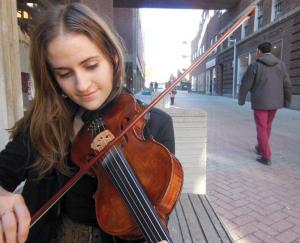December 30, 2015
 For Jenna Moynihan, studying at the Berklee College of Music and exploring Boston’s vibrant folk/traditional environment was a way to find herself. “I had lots of great musicians to listen to and learn from. But eventually you have to get out of mimicking. You’ve got to take off the headphones and listen to yourself.” Sean Smith photoHanging in Jenna Moynihan’s Somerville apartment is a clump of elaborately tangled strands of colored yarn. It’s neither a knitting project gone horribly wrong nor a cat’s over-used plaything; it’s a unique keepsake related to her recently released debut CD, appropriately titled “Woven” – a beguiling mix of Celtic and American fiddle influences.
For Jenna Moynihan, studying at the Berklee College of Music and exploring Boston’s vibrant folk/traditional environment was a way to find herself. “I had lots of great musicians to listen to and learn from. But eventually you have to get out of mimicking. You’ve got to take off the headphones and listen to yourself.” Sean Smith photoHanging in Jenna Moynihan’s Somerville apartment is a clump of elaborately tangled strands of colored yarn. It’s neither a knitting project gone horribly wrong nor a cat’s over-used plaything; it’s a unique keepsake related to her recently released debut CD, appropriately titled “Woven” – a beguiling mix of Celtic and American fiddle influences.
As Moynihan explains, her photographer friend Lauren Desberg had an idea for the CD cover images to complement the title: that Moynihan wrap yarn around her fiddle, and herself. “My original thought was just to use one thread, but she said, ‘No, let’s go all out.’ It was actually pretty easy to set it all up. But getting out of it – that was harder. So I wound up with this big knot, and now every time I see it I think, ‘There’s my album.’”
Moynihan’s choice for the title wasn’t random. “Woven” happens to be on Moynihan’s list of favorite words, and it’s one of her favorite metaphors, too. For one thing, it evokes her experience in Boston after she arrived in 2009 from her hometown in New York’s Southern Tier to attend Berklee College of Music. Like many a Celtic musician new to the area, she quickly found that Boston’s folk and traditional music scene has many intertwining threads – plentiful sessions, parties or other get-togethers, at which there are numerous creative people to provide inspiration and possibly even collaboration.
She has performed locally at BCMFest and Club Passim, and with the Boston Pops at Symphony Hall, and teamed up with established musicians like Matt Glaser, Bruce Molsky, Kimberley Fraser, and Phil Cunningham. Moynihan’s ongoing partnerships include a duo with Scottish harpist Mairi Chaimbeul and bands led by genre-breaking fiddlers Laura Cortese and Darol Anger (who calls her “one of the best of the new generation of freestyle fiddlers”).
“Woven” also describes a temperament, a mindset for Moynihan: “It’s what I think about when I play.” She’ll hang onto the melody and explore it, as if picking up and holding fast a thread between her fingers; then she’ll pick up other threads – like variations in fingering or bowing – and continue on, even as her fellow musicians add their own textures to the tune, whether it’s from the Scottish tradition that has been her focus, her own composition or another contemporary piece. The tapestry that results is intricate, yet not to the point of obscuring – or preventing enjoyment of – the fundamental elements of the work as a whole.
 Woven
Woven
“I use my playing to display the melody,” she says, “instead of the other way around.”
Supporting her admirably throughout “Woven” is Chaimbeul and her bewitching harp, with guitar from Owen Marshall and Courtney Hartman; Anger, Duncan Wickel and Alex Hargreaves contribute fiddle; and Maeve Gilchrist plays keyboard on two tracks, supplementing her vital role as producer.
The Scottish roots of Moynihan’s playing are on full display on tracks like “Dolina MacKay,” written by John Scott of South Uist; the pipe tune “Major Campbell Graham”; and a trio of reels that comprises two traditional pieces, “Rise Ye Lazy Fellow” and “The Mill Stream” and her own “The Night We Had the Bears” – forthright, bold strokes with the familiar Scottish flicks, scrunches and other grace notes.
But these characteristics are less prominent elsewhere, and Moynihan’s fiddling sounds more contemplative and even a little improvisatory, especially on her own compositions like “Haven” and “The Chill on Montebello”; the latter track, in fact, has an unmistakable American-style groove to it, with Anger darting hither and yon around the melody line. Then there’s the traditional “O’Sullivan’s March,” played slowly and with the rhythmic edges rounded off; the trio of Moynihan, Wickel and Hargreaves gradually and unhurriedly each construct their own individual strands and all the while intertwining them – if you’re looking for a true “Woven” metaphor, this would be it.
Moynihan grew up in the town of Lakewood, about an hour-and-a-half southwest of Buffalo, and as a schoolchild began Suzuki lessons. But she believes she may have been “predisposed” at an earlier age to develop an appreciation for Celtic music: “When my dad drove me to pre-school, he would play the Chieftains’ ‘Long Black Veil’ album on the car stereo. There’s a song on there called ‘Changing Your Demeanor’ that I absolutely loved, and we would listen to it over and over.”
As it turned out, her Suzuki teacher had a fondness for Celtic music, to the point where Moynihan and a few of her fellow violin students formed an informal “fiddle club.” Then when she was eight, she went to a Highland Games festival where she took a workshop from Jeremy Kittel, an American-born fiddler who has helped lead the cross-genre wave in blending Scottish/Celtic traditions with jazz, classical and other influences.
Thus the Scottish/Celtic thread appeared in Moynihan’s life. She began listening to “every fiddle album I could get, like Alasdair Fraser, Natalie MacMaster and Blazin’ Fiddles – I was kind of obsessed.” She went to fiddle camps like Valley of the Moon, where she not only strengthened her grasp of Scottish music but also got a foundation in other fiddle styles, and met innovative fiddlers like Glaser, Fraser and Hanneke Cassel.
“Different camps foster different priorities and directions,” says Moynihan. “Valley of the Moon was an important formative experience, because I feel that was where the message came loud and clear: It’s safe to be who you are, and you can create what you want to create.”
As she began considering colleges, Moynihan knew she didn’t want to go the classical-conservatory route, but she didn’t want to be a student of Celtic music, either. Her aspiration was to find herself.
“I had lots of great musicians to listen to and learn from,” she explains. “But eventually you have to get out of mimicking. You’ve got to take off the headphones and listen to yourself.”
At Berklee – where she majored in performance with a minor in American roots – she did that and more, guided by mentors like Anger, Glaser and Mark Simos, and through meeting other musicians at Berklee and elsewhere in the Boston area.
“It was a big-picture type of experience,” she says. “The first few years, I was playing styles I was not at home with, like Appalachian music, and that took a certain amount of nerve. There were times I felt out of my element, but that forced me to explore and go beyond what I knew. I just kept going and went through it all, until I could say, ‘OK, this is me.’ I wanted to own who I was.”
One of the most important relationships she formed at Berklee was with Chaimbeul, who arrived as a freshman from the Isle of Skye when Moynihan was starting her senior year. Moynihan had heard about Chaimbeul from mutual friends, and invited her to perform together at a Berklee event: “Our first meeting was a rehearsal, our second was a gig.” They developed an instant rapport that led to more gigs and, in 2014, a CD/EP titled “Back & Forth.”
“We’ve grown a lot together musically, and Mairi also has become my best friend,” says Moynihan. “We hear things in similar ways, in that we feel very connected to the Scots genre and tradition but are inspired by other music.”
“Back & Forth” was helpful to Moynihan as she contemplated making her own CD, which she knew she wanted to do but was unsure what form it should take. “I’m not now, nor was I before, pursuing ‘The Jenna Moynihan Solo Project.’ What I felt strongly was that I should include people I fully trust, musically and otherwise.”
Gilchrist in particular did yeoman’s work as producer and wrote out the parts for “O’Sullivan’s March”: “Maeve was a great sounding board. I have so much respect for her,” says Moynihan. “I had a sense of what would happen on ‘O’Sullivan’s March,’ but I didn’t hear it until we recorded a take, and it was just wonderful.”
In fact, what Moynihan relishes most about recording “Woven” are “the things that came together in the moment,” like “O’Sullivan’s March” as well as “Delina MacKay,” which features outstanding dual guitar from Marshall (rhythm) and Hartman (melody): “I wasn’t sure if it would work. I wondered, ‘Are they going to step on each other?’ But they made it a powerful track.”
(Marshall’s contribution to “Woven” went beyond his guitar accompaniment: He drove Moynihan and Chaimbeul to the recording studio on a day the buses weren’t running because of Boston’s February snowpocalypse.)
While – to continue with the weaving metaphor – “Woven” represents the fabric of Moynihan’s music, new threads continue to emerge. In particular, she’s finding her membership in Laure Cortese and the Dance Cards yet another formative experience.
“In that context, I’m playing a supportive role, which I haven’t really done before. I’m even doing some singing. So I’m finding skill sets I haven’t normally worked with, and this means challenging myself: How do I make everything sound stronger? It’s nice to keep moving forward.”
Correction: A previous version of this story gave the wrong name for photographer Lauren Desbergr.

